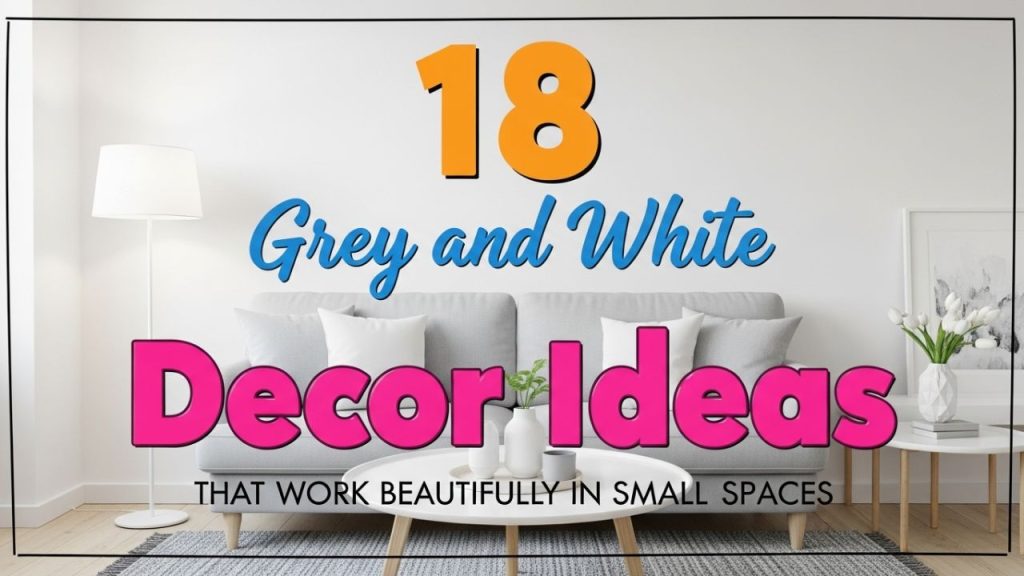When decorating a small space, it’s easy to fall into the trap of overcompensating — either with bold colors or too many accessories.
But the timeless combination of grey and white offers the perfect balance of sophistication and space-enhancing lightness.
Whether you’re working with a studio apartment or a compact bedroom, these ideas show how grey and white can bring clarity, depth, and elegance into any tight area.
Below are 18 beautifully practical grey and white decor ideas — each tailored to maximize both style and space.

Table of Contents
1. Light Grey Walls with Crisp White Trim
Soft grey walls instantly add warmth without closing in a room. White trims and moldings break the monotony and define the architecture.
Why it works:
- Light grey adds subtle contrast without overwhelming.
- White trims highlight windows and doors, making the room feel more structured and open.
How to do it:
- Choose a warm or cool light grey depending on your room’s natural light.
- Use bright white semi-gloss paint for trims.
Avoid:
- Overly dark greys unless the space is very well-lit.
- Creamy or yellowish whites that can clash.
Also Read: 33 Dark Boho-Gothic Home Decor Ideas
2. Grey Sofa with White Cushions
A grey sofa grounds your living space, while white cushions keep things airy and soft.
Why it works:
- It anchors your seating area without feeling too bulky.
- Swappable white cushions brighten and soften the look.
How to do it:
- Opt for a slim-profile sofa in grey linen or velvet.
- Mix cushion textures—cotton, faux fur, cable knit.
Avoid:
- Matching grey-on-grey cushions which flatten the look.
- Oversized furniture in tight spaces.
3. Two-Tone Kitchen Cabinets
A small kitchen can feel more dynamic with grey lower cabinets and white uppers.
Why it works:
- White on top reflects light; grey below grounds the room.
- It adds depth without using multiple colors.
How to do it:
- Use matte or satin finishes to reduce reflection.
- Add sleek brass or black hardware for modern contrast.
Avoid:
- Busy backsplash tiles—keep it simple and clean.
4. Grey and White Area Rug
Rugs define zones in small spaces. A patterned rug in these tones adds interest and subtle separation.
Why it works:
- Helps break up open-plan spaces without walls.
- Visual texture without color overload.
How to do it:
- Choose geometric or faded traditional patterns.
- Go for low-pile to avoid bulk.
Avoid:
- Small rugs that “float” under furniture—always go larger.
5. Grey Accent Wall Behind the Bed
In a compact bedroom, a grey wall can act like a headboard, adding depth and elegance.
Why it works:
- Visually expands the room’s length or height.
- Creates a focal point without clutter.
How to do it:
- Paint only the headboard wall.
- Pair with white bedding and light wood tones.
Avoid:
- Dark grey on multiple walls—it can feel enclosing.
6. White Curtains with Grey Borders
Sheer white curtains keep light flowing while a grey border adds definition.
Why it works:
- Maintains brightness while framing windows elegantly.
- Grey border subtly draws the eye upward.
How to do it:
- Hang curtains high and wide beyond the window frame.
- Choose linen or cotton blends for lightness.
Avoid:
- Heavy blackout curtains unless necessary.
7. Grey and White Wall Art Gallery
Use grey-scale prints or photos in white frames for visual interest without crowding the walls.
Why it works:
- Adds personality without introducing loud colors.
- Keeps walls feeling light yet curated.
How to do it:
- Use uniform frame sizes or a balanced asymmetry.
- Stick to black & white photography or minimalist line art.
Avoid:
- Mixing too many art styles or frame types.
8. Textured Throws in Grey and White
Layering throws in different textures creates coziness and sophistication.
Why it works:
- Adds depth and comfort without using bold patterns.
- Textures reflect light differently, giving visual layers.
How to do it:
- Drape a chunky knit grey throw over a white chair or bed.
- Add a waffle or fringe detail for interest.
Avoid:
- Glossy synthetic materials that look out of place.
9. White Furniture with Grey Accents
A white desk or dresser with grey knobs, trim, or top can add subtle contrast.
Why it works:
- Keeps large furniture light and non-dominant.
- Grey details create a cohesive theme.
How to do it:
- Paint drawer knobs or use grey contact paper on surfaces.
- Add a grey chair or accessories nearby.
Avoid:
- All-grey furniture that might weigh down the room.
10. Grey Tile Backsplash in a White Bathroom
Bathrooms benefit from a grey herringbone or subway tile to create dimension.
Why it works:
- Makes small bathrooms feel more refined.
- Grey hides grime better than all-white.
How to do it:
- Use medium grey tiles with white grout.
- Pair with a large round mirror and white vanity.
Avoid:
- Glossy tiles that overly reflect artificial light.
11. Compact Grey Accent Chairs
Slim, armless grey chairs fit neatly in corners or reading nooks.
Why it works:
- Provides extra seating without visual clutter.
- Grey hides wear better than lighter tones.
How to do it:
- Choose clean silhouettes in mid-century or Scandinavian styles.
- Add a white pillow for softness.
Avoid:
- Overly tufted or bulky styles that eat up space.
12. White Walls with Grey Ceiling
Flip the usual look for dramatic elegance in a small space.
Why it works:
- Unexpected and stylish.
- Makes a short ceiling appear taller when done right.
How to do it:
- Use a very pale grey (not charcoal).
- Add white crown molding if possible.
Avoid:
- Dark ceiling with low lighting—it can feel oppressive.
13. Grey and White Striped Bedding
Stripes elongate the bed visually and add a hotel-like freshness.
Why it works:
- Adds subtle pattern and movement.
- Keeps the bed feeling crisp and inviting.
How to do it:
- Choose horizontal stripes for width, vertical for height.
- Pair with solid grey throw pillows.
Avoid:
- Overmixing patterns in small rooms.
14. Grey Floating Shelves on White Walls
They offer storage without overwhelming the room.
Why it works:
- Looks architectural and sleek.
- Keeps the visual weight balanced.
How to do it:
- Use 2–3 staggered shelves with neutral accessories.
- Install at eye level.
Avoid:
- Deep, bulky shelving units in narrow spaces.
15. White Brick or Faux Brick Wall with Grey Decor
Adds character and texture in studio spaces or hallways.
Why it works:
- Creates a loft-like feel while remaining neutral.
- Grey soft furnishings balance the rugged look.
How to do it:
- Use peel-and-stick panels if you’re renting.
- Keep other walls simple and clean.
Avoid:
- Mixing brick with heavy wood tones—it can feel dated.
16. Monochrome Gallery in Greyscale Tones
Use abstract or line art in shades of grey on white walls.
Why it works:
- It’s artistic yet subtle.
- Works especially well above beds or sofas.
How to do it:
- Stick to thin black frames or floating mounts.
- Maintain equal spacing for order.
Avoid:
- Oversized canvas pieces that overwhelm the space.
17. Compact Grey Storage Ottomans
Multi-functional storage that doesn’t sacrifice style.
Why it works:
- Adds seating, hides clutter, and keeps the palette cohesive.
- Blends seamlessly into grey-white schemes.
How to do it:
- Pick a tufted or smooth design depending on your theme.
- Pair with white rug or chair for contrast.
Avoid:
- Large cube-style ottomans that dominate the room.
Also Read: 21 Small-Space Boho Home Decor Ideas For You
18. Layered Window Treatments: White Blinds + Grey Sheers
Combining textures without adding color.
Why it works:
- Sheers diffuse light; blinds offer privacy.
- Adds elegant layering to flat windows.
How to do it:
- Mount blinds inside the frame, sheers outside.
- Stick to light greys to keep the airiness.
Avoid:
- Heavy drapery or full blackout if light is already limited.
Conclusion
Decorating a small space doesn’t mean sacrificing style — and the combination of grey and white proves just that.
These two tones, when thoughtfully layered and balanced, create interiors that feel both calm and spacious, yet still visually interesting.
From grey accent walls to white furniture with subtle contrast, each idea above helps maximize your space’s potential without overcrowding it.
The key lies in texture, proportion, and contrast. Grey adds grounding and depth, while white keeps things airy and open.
Whether you’re updating a single room or styling a whole apartment, these grey and white decor ideas will help you create a space that feels elevated, intentional, and perfectly suited for small living.
Start small — even a few changes can make a big difference. Let the palette work for you, not against your space.








